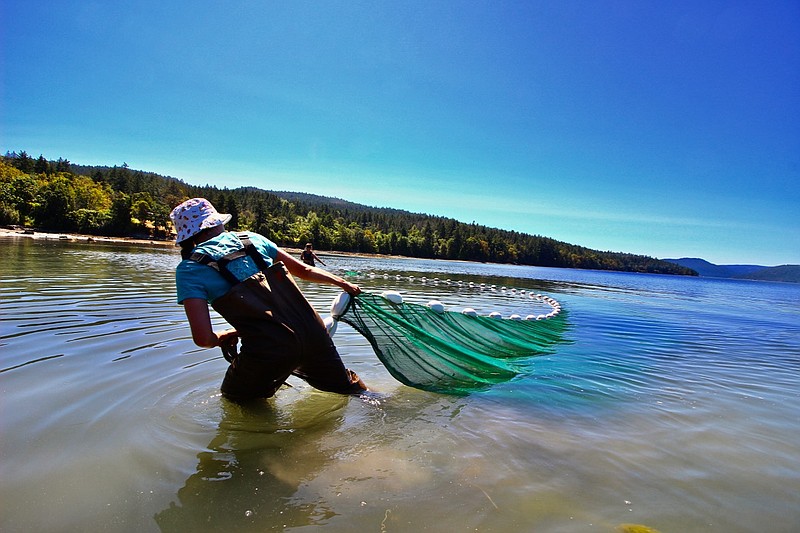Americans are eating a minimum of tens of thousands of particles of microplastics every year, according to a first-of-its-kind study that could have major implications for people living in the Tennessee Valley.
The Tennessee River has the most microplastic of any river ever studied (although microplastic studies are still in their infancy). Microplastics are tiny, often microscopic, pieces of plastic that have broken down. The new study is the first to estimate the annual microplastics consumption for humans and shows the problem may be worse than feared.
"I noticed that as single studies were coming out, it was really hard for people to understand the full context of this. You would see a study about microplastics in water or seafood but that really doesn't allow people to navigate their full microplastic consumption," said University of Victoria Ph.D. candidate Kieren Cox, one of six scientists to work on the study. "It also doesn't give them full context, and as scientists, that's something that we owe the public."
The report was published in the Environmental Science and Technology peer-reviewed scientific journal. It combined 26 studies and estimated Americans each consume 39,000-52,000 microplastic particles per year. Those numbers increase to 74,000-121,000 when microplastics that are inhaled are included. Infant females consume the least and adult males the most, the study found.
The study was based on the recommended daily caloric intake for each food group. However, it only examined about 15% of Americans' diets - seafood, sugars, salts, honey, alcohol, as well as tap and bottled water - meaning the amount of microplastics people consume is likely be much higher, according to the report's authors. Other foods that make up the majority of Americans' diets such as meat, grains and vegetables were not included due to a lack of data. The particles enter the food supply in a number of different ways: the water supply, in animals' food, and, some studies suggest, through the air.
"These estimates substantially increase values previously provided by researchers who focused on single types of food or beverages," the study reads.
What does it all mean? No one knows for sure, yet. Eating 50,000 microplastic particles per year may sound like a lot, but there aren't studies showing the impact of microplastic consumption on humans - though other studies have demonstrated microplastics are harmful in fish and other smaller organisms.
Work by the University of Newcastle commissioned by the World Wildlife Federation used the data to determine humans eat more than 5 grams of microplastics per week, about the weight of a credit card. Cox was skeptical about the amount as microplastics range widely in size. The Newcastle report stressed that point, but the study does begin to paint a picture of just how much people may be eating.
The University of Victoria study is part of the natural progression of microplastic research, according to scientists. They have worked for several years to determine how much microplastic is in certain bodies of water and the food listed in the study. Now, it's about determining how much people are ingesting and what the implications are.
"The bottom line is microplastics seem to be everywhere," said Martin Knoll, a professor of geology and hydrology at Sewanee: The University of the South. "That's what we're finding out. I'm not really surprised that these numbers can be really high for total annual intake by people in the United States. That doesn't surprise me. I think we're going to find out as this budding research continues, just how prevalent they are in our environment."
Knoll helped German scientist Andreas Fath, a chemistry professor at Furtwangen University, conduct research about surface pollutants on the surface of the Tennessee River. That study was released in 2018 and found the river has 80 percent more microplastic than China's Yangtze River - which a study found to be the source of 55 percent of all river-born plastic entering the ocean - and 8,000 percent higher than the Rhine River in Europe, a much more heavily populated area.
Knoll was complimentary of the study and said it's an important development but added there is little uniformity in current microplastic studies from which the report pulled. For example, one study used found huge amounts of microplastics in water sources, while others have been far more conservative in their findings. Existing studies haven't had inconsistent findings because there aren't yet standard operating procedures. Most of that is due to how researchers define microplastic. The smaller the size scientists examine, the more microplastic they're going to find, so findings often hinge greatly on the size ranges chosen.
"It's how science works, you get this good research, then you have to dig deeper," Knoll said.
The new study by Cox and his team is a first look estimating a wide scope of consumption amounts. It's not meant to be used as exact amount but rather begins to paint a picture about how much plastic is being consumed.
Now, it's about digging deeper and answering how much plastic is consumed in a full diet, Cox said. They'd like to determine how much is in the other 85% of people's recommended diet.
"I personally think the big takeaway is that we are consuming a large number of plastics," Cox said. "That is really a function of our overreliance on it. It has put plastic into a vast majority, if not all, of our ecosystems. As we are the major benefactor of the ecosystems, it's not surprising that plastic has made its way into our consumption. Unless we start to mitigate our mismanagement and overproduction of plastics, this is going to continue to happen."
Contact Mark Pace at mpace@timesfreepress.com or 423-757-6659. Follow him on Twitter @themarkpace and on Facebook at ChattanoogaOutdoorsTFP.
